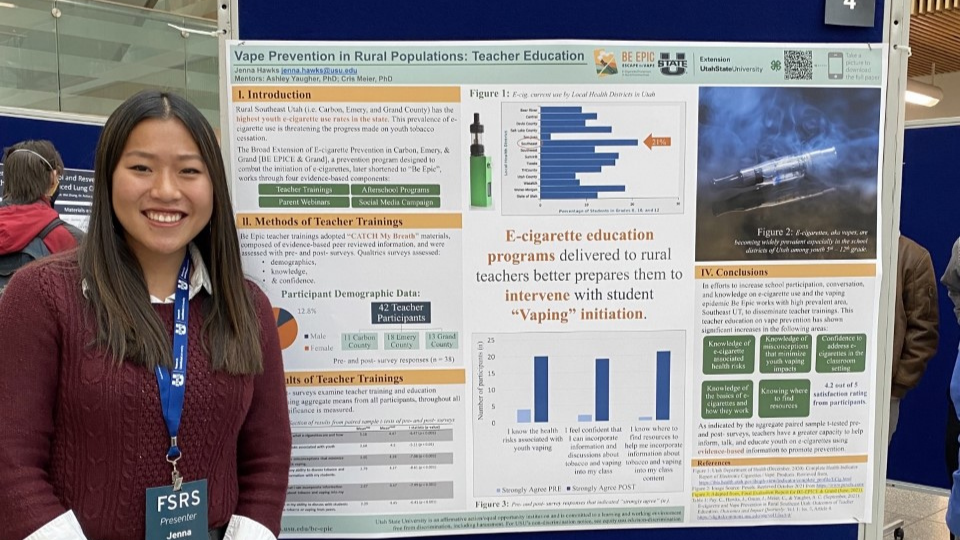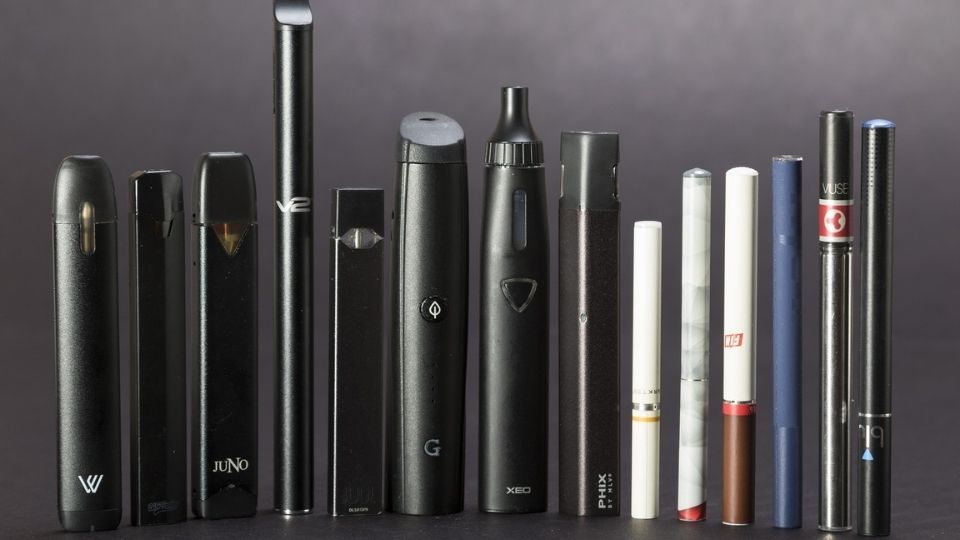Vaping and Youth: How Parents Can be Involved

What are E-cigarettes?
An e-cigarette is a battery-operated device that heats a liquid into a “vapor” so that it can be inhaled. Since first introduced in the United States in 2006, the industry has grown in popularity especially among youth and young adults (Chun et al., 2017). E-cigarettes come in many forms with different shapes, sizes, names, and functions, and can be as small as a flash drive (CATCH, 2020). Some e-cigarettes are designed to look like combustible smoking cigarettes (the traditional rolled cigarette) and are non-re-usable, while others have large tanks attached to them and are chargeable called mods (CATCH, 2020). No matter their name: pods, mods, cig-a-like, or vape pens, they all contain an e-liquid or e-juice that is breathed into the lungs as “vapor”. Chemicals such as propylene glycol and vegetable glycerin are found in this e-liquid and when heated form a toxic compound, aldehyde (Chun et al., 2017). It’s a common misconception, but what many people refer to as “just vapor” is actually an aerosol, which is toxic. An aerosol is a thick mist or spray, containing substances and many chemicals that when inhaled damage the user’s stomach tract, lungs, and mouth (CATCH, 2020). Other toxic materials are contained in the e-liquid as well, such as metals like lead, nickel, and tin all carcinogens (i.e., a cancer-causing agent), and nicotine (CATCH, 2020). Additionally, other substances such as marijuana in a liquid form can be added into e-cigarette devices and are found to deliver high concentrations of Tetrahydrocannabinol (THC; a marijuana compound; CATCH, 2020; HHS, 2016).
Why are E-Cigarettes Bad for Youth?
Although some e-liquids are marketed as “nicotine free”, one study found that 99% of e-cigarette products contained nicotine (Marynak et al., 2017). Unfortunately, there are very minimal regulations on e-cigarettes currently. While an individual must be 21 or older to purchase a tobacco product (e-cigarettes included in that category), youth are finding alternative ways to gain access to e-cigarettes (Sharpless, 2019; McKeagoney et al., 2019). Often youth do not know the risks of e-cigarette use due to excluded labeling information (Cobb, et al., 2020).
The use of e-cigarettes is especially growing in popularity among youth who are calling it vaping or JUULing. These slang terms reference the vape that appears like a cloud when users exhale and the widely popular brand of e-cigarette products – JUUL. This new terminology has been adopted by youth who participate in e-cigarette use. However, all e-cigarettes, no matter the brand, are harmful due to the chemicals used (CATCH, 2020).
Effects of Youth Vaping:
Youth who vape are 6.8 times more likely to start smoking cigarettes within 18 months compared to non-e-cigarette users (CATCH, 2020). Vaping also increases the frequency of cigarette smoking in past 30 day use for those who are experimenting with traditional cigarettes (Stalgaitis et al., 2020; Soneji et al., 2017). This suggests that e-cigarettes are a gateway drug for youth, meaning that use of that substance leads to an increased likelihood of using other substances later. Additionally, e-cigarette use and traditional cigarette use has been linked to increased substance use, marijuana use, binge drinking, and poor grades (Evans-Polce et al., 2020). 80% of e-cigarette users in one study survey said that they vaped because they could use e-cigarette products in places and times when traditional cigarettes are not allowed (Pierce et al., 2021). Because e-cigarettes are relatively new to the market, the effects of e-cigarette use on youth later in life as adults (long-term) are continuing to be investigated; however, the following effects of vaping on youth have been observed:
Physical:
Youth vaping is related to lung illnesses such as asthma and bronchitis (Stalgaitis et al., 2020) and is associated with an increased severity of these infections (Cho & Paik, 2016). For example, 55% of patients with e-cigarette injuries admitted between 13 different hospitals were put in the intensive care unit (ICU; Blagev et al., 2019). These lung diseases seem to be associated with the vitamin E acetate in vape products; however, other sources are currently being investigated since there may be multiple causes (CATCH, 2020). Vitamin E acetate, most often in vape products containing THC, can cause significant lung damage when inhaled (CDC, n.d.). Another chemical not safe to inhale is diacetyl, a flavoring chemical in e-liquid, that contributes to the development of asthma, chronic obstructive pulmonary disease (COPD), and popcorn lung (an irreversible life-long lung disease; Vape Danger, n.d.).
In addition, vaping elevates heart rate and increases blood pressure for longer periods of time, increasing the chance of harm to one’s heart and blood vessels (Yan & D’Ruiz, 2015). Users who vaped daily are at an increased risk of having a heart attack (Alzahrani et al., 2018). It has been reported that the chemicals contained in the e-cigarette vapor also cause sores and dry out the mouth (CATCH, 2020). Nausea, vomiting, and general pain in the abdomen have also been reported after vaping (Blagev et al., 2019).
Mental:
Nicotine use can have serious consequences to youth cognition and mental health because their brains are still developing. Brain development does not finish until around age 25 and by then individuals can purchase tobacco products themselves (CATCH, 2020).
Nicotine in e-cigarettes harms the connections built between brain cells when new memories or skills are created, a process called synapse formation, disrupting youths’ pleasure feedback (CATCH, 2020). Youths’ higher sensitivity to those reward properties results in a greater chance of habitual substance use compared to adult use (Dwyer et al., 2009). Nicotine impacts development associated with memory and attention resulting in cognitive issues later in life, as well as contributes to an increase in anxiety and irritability affecting their mental health (Stalgaitis et al., 2020; CATCH, 2020). Despite nicotine’s bitter taste, e-cigarettes are still being consumed because the harsh tastes are often masked behind flavored vape juice such as fruit and even dessert flavors (Leventhal et al., 2020).
Social:
E-cigarette use can impact the moods and behaviors of its users. Nicotine contributes to mood swings, impaired impulse control, increased anxiety, and increased irritability as well as, tendencies to withdraw from class, peers, family, and other social events (CATCH, 2020; Popova et al., 2021). This may result in a decreased quality of academic work and poorer performance in athletic events and other activities/clubs (CATCH, 2020). Overall, vaping is associated with a sense of disengagement in youth. Users and parents alike can often miss these signs by attributing these changes in behavior to normal teenage functioning when in fact they are due to the effects of nicotine (Popova et al., 2021).
Experiences of Youth who Don't Vape:
According to Utah’s Student Health and Risk Prevention (SHARP) Survey given to students in 6th, 8th, 10th, and 12thgrades, specific experiences were identified as protective factors (i.e., things that decrease the likelihood) against e-cigarette initiation and frequency of use. The following are protective factors according to the Utah Department of Human Services (DHS, 2019):

Family Attachment:
When a young person feels a part of their family, they are at a decreased risk of initiating e-cigarette use.
In 2019, 85.8% of students in the Four Corners District (i.e., Carbon, Emery, and Grand Counties) said that they felt attached to their families and chose not to use vape products in the past 30 days (Bach-Harrison, 2020). Examples of ways to promote family attachment include family movie or game nights, cooking with each other, and sitting down for family meals together.
Belief in the Moral Order:
Youth are continuously developing skills and assessing what they believe is ‘right’ and ‘wrong’. This is having a belief in moral order. Youth who have a strong moral order towards the negative effects of e-cigarettes have a decreased risk of initiating e-cigarette use. For youth who had a sense of moral order or whose friends had that belief 85.6% of students in the Four Corners District chose not to vape (Bach-Harrison, 2020).
Opportunities for Prosocial Involvement:
If a young person has opportunities to be involved with community, family, and/or friend activities, they are less likely to initiate use of an e-cigarette.  In the Four Corners District 84.9% of students who had prosocial peers also chose not to use vape products in 2019 (Bach-Harrison, 2020).
In the Four Corners District 84.9% of students who had prosocial peers also chose not to use vape products in 2019 (Bach-Harrison, 2020).
Rewards for Prosocial Involvement:
If youth are consistently rewarded for their positive behaviors, whether it be by family, peers, or community members, they are less likely to initiate e-cigarette use. Ways to promote prosocial involvement in your youth include encouragement, praise, and recognizing their involvement and participation in things such as sports, activities, clubs, volunteer programs, and school.
What Can Parents Do?
Youth often don’t realize that there is nicotine in most e-cigarettes (Singh et al., 2020); talking with your youth can educate them and decrease the likeliness that they will vape. Finding a way to talk with your youth about this topic can be hard and even uncomfortable but it can help them make the decision not to vape. Although it may not seem it during difficult times, parents play important roles and have large influences on their youth (Patel et al., 2019). Here are four strategies to use when talking to your child about vape and preventing use of e-cigarettes:
Talking to your child about vaping
| What | Clearly set expectations and be sure to be direct. Communicate your expectations with your youth clearly and lovingly. |
|---|---|
| Why | Avoid using singular reasoning such as ‘it’s bad for you’ instead try explaining why it is harmful/the evidence. Focusing on immediate consequences rather than long-term are generally more effective for youth. |
| How | It’s important to teach your youth how to respond if someone invites them to smoke. Learn different refusal methods and exit strategies so you can share them with your children. For example, visit: https://www.kidpower.org/library/article/tobacco-refusal/ |
| If | If your child is experimenting with e-cigarettes express your disapproval while remaining a loving parent. A reminder about the family rules may need to be restated, and have clear smaller or more direct consequences. Consequences that are too large may push them farther. If despite the consequences your child is still using e-cigarettes help them by seeking professional help or by showing them this website: http://truthinitiative.org/thisisquitting or text: DITCHJUUL to 88709 |
(CATCH Parent-toolkit, 2020). For more information, examples, and resources visit: https://digitalcatchdirectuploads.s3-us-west-2.amazonaws.com/thinkific/cmb/CATCH+My+Breath+Parent+Toolkit.pdf

Since e-cigarettes can be easily hidden it’s important for parents to be aware of youth use and be prepared before there is ever an issue (Wu & Chaffee, 2020). Rather than simply discussing tobacco use in general terms, setting tobacco-free house rules that everyone living in/visiting follows decreases e-cigarette use initiation (Wu & Chaffee, 2020). Remember conversations are better than lectures and honestly answering your youths’ questions can help prevent their use of e-cigarettes (California Department of Public Health, n.d.).
Finally, watch for signs of youth vaping (California Department of Public Health, n.d.; CATCH, 2020), including:
- Usually calm and easy going but now is anxious and irritable.
- Difficulty concentrating can be attributed to a nicotine withdrawal which may lead to poorer grades.
- Sudden interests in cheap candles, incense, or perfume/cologne which can be used to hide the smell of their e-liquid.
- A change in eating patterns resulting in weight fluctuation (gain or loss).
- Unexplained mouth sores, mouth dryness, nosebleeds, or irritation around the mouth can be due to the chemicals in the aerosol or “vapor”.
- Sweet smells coming from their rooms.
- Unrecognizable tech products, cords/chargers, and or batteries.
- Unexplained purchases.
- Constant headaches and nausea
Resources*
- Parent Resources on CATCH-My-Breath Curriculum: https://letsgo.catch.org/pages/CMB-Parent-Resources
- Parent Tip Sheet to talking about E-cigarettes: https://e-cigarettes.surgeongeneral.gov/documents/SGR_ECig_ParentTipsheet_508.pdf
- Parents Empowered preventing youth alcohol and substance misuse: https://parentsempowered.org/how/
- Introductory Informative Videos on Vaping: http://www.scholastic.com/vapingrisks/index.html
- Quick Facts Parents should know about Vaping: https://www.lung.org/quit-smoking/e-cigarettes-vaping/e-cigarettes-parents
- Real Teens talk about Vaping: https://www.youtube.com/watch?v=gjYT4YG7jOk
- Tips and Tools to quitting with Smokefree Teen: https://teen.smokefree.gov/
- Have your kid download tobacco free apps: Escape the Vape https://apps.apple.com/us/app/escape-the-vape/id1482436533 Quuit- Quit Vaping Now: https://apps.apple.com/us/app/quuit-quit-vaping-now/id1493133459
- Get Support from doctors, schools, and other leaders in your community.
- Text DITCHJUUL to 88709
*Please note that all of the resources provided are for educational purposes and Utah State University (USU) does not specifically endorse their services. Resources are intended to provide information, not to treat substance use/vape use or other mental health concerns. USU does not control the websites or books referenced above.
References
- Alzahrani, T., Pena, I., Temesgen, N., & Glantz, S. A. (2018). Association between electronic cigarette use and myocardial infarction. American Journal Preventive Medicine. 55(4):455-461 https://doi.org/10.1016/j.amepre.2018.05.004
- Blagev, D. P., Harris, D., Dunn, A. C., Guidry, D. W., Grisson, C. K., & Lanspa, M. J. (2019). Clinical presentation, treatment, and short-term outcomes of lung injury associated with e-cigarettes or vaping: A prospective observation cohort study. Lancet, 394(10214), P2073-P2083. https://doi.org/10.1016/S0140-6736(19)32679-0
- Bach-Harrison (2020). Utah Department of Human Services: Substance Abuse and Mental Health: Utah SHARP Web Tool. Retrieved November 25, 2020 from http://www.bach-harrison.com/utahsharpwebtool/Crosstabs.aspx
- California Department of Public Health. (n.d.). Parent resources. Flavors Hook Kids, Tobacco Free CA. Retrieved December 10, 2020 from https://www.flavorshookkids.org/parent-resources/
- CATCH-My-Breath. (2020). CATCH My Breath Vaping Prevention Program: State of the union of the youth vaping epidemic and introduction to an evidence-based prevention program. CATCH My Breath. Retrieved November 25, 2020 from https://letsgo.catch.org
- CATCH-My-Breath. (2020). Parent Toolkit: Middle and High School. CATCH My Breath. Retrieved November 25, 2020 from https://letsgo.catch.
- CDC. (n.d.). Smoking & Tobacco Use: Outbreak of Lung Injury Associated with E-cigarette Use, or Vaping. Centers for Disease Control and Prevention. Retrieved January 8, 2021 from
- https://www.cdc.gov/tobacco/basic_information/e-cigarettes/severe-lung-disease.html#key-facts-vit-e
- Cobb, N. K., & Solanki, J. N. (2020). E-cigarettes, Vaping Devices, and Acute Lung Injury. Respiratory Care, 66(5), 713-718. https://doi.org/10.4187/respcare.07733
- Cho, J. H. & Paik, S. Y. (2016). Association between electronic cigarette use and asthma among high school students in South Korea. PLoS One, 11(3), e0151022. https://doi.org/10/1371/journal.pone.015102
- Chun, L., Moazed, F., Calfee, C., Matthay, M., & Gotts, J. (2017). Pulmonary toxicity of e-cigarettes. American Journal of Physiology, 313(2), L193-L206. https://doi.org/10.1152/ajplung.00071.2017
- Dwyer, J. B., McQuown, S. C., & Leslie, F. M. (2009). The dynamic effects of nicotine on the developing brain. Pharmacology & Therapeutics, 122(2), 125-139. https://doi.org/10.1016/j.pharmthera.2009.02.00
- Evans-Polce, R. J., Veliz, P., Boyd, C. J., & McCabe, S. E. (2020). Initiation patterns and trends of e-cigarette and cigarette use among US adolescents. Journal of Adolescent Health, 66(1), 27-33. https://doi.org/10.1016/j.jadohealth.2019.07.00
- HHS. (2016). E-cigarette Use Among Youth and Young Adults: A Report of the Surgeon General. U.S. Department of Health and Human Services [HHS]. Retrieved January 13, 2021 from https://e-cigarettes.surgeongeneral.gov/documents/2016_SGR_Full_Report_508.pd
- Leventhal, A. M., Mason, T. B., Cwalina, S. N., Whitted, L., Anderson, M. K., & Callahan, C. E. (2020). Flavor and nicotine effects on e-cigarette appeal in young adults: Moderation by reason for vaping. American Journal of Health Behavior, 44(5), 732-743. https://doi.org/10.5993/AJHB.44.5.1
- Marynak, K. L., Gammon, D. G., Rogers, T., Coats, E. M., Singh, T., & King, B. A. (2017). Sales of nicotine containing electronic cigarette products: United States, 2015. American Journal of Public Health, 107(5), 702-705. https://doi.org/10.2105/AJPH.2017.303660
- McKeganey, N., Russell, C., Katsampouris, E., & Haseen, F. (2019). Sources of youth access to JUUL vaping products in the United States. Addictive Behaviors Reports, 10,100232. https://doi.org/10.1016/j.abrep.2019.100232
- Patel, M., Czaplicki, L., Perks, S. N., Cuccia, A. F., Liu, M., Hair, E. C., Schillo, B. A., & Vallone, D. M. (2019). Parents’ awareness and perceptions of JUUL and other e-cigarettes. American Journal of Preventive Medicine, 57(5), 695-699. https://doi.org/10.1016/j.amepre.2019.06.012
- Pierce, J. P., Chen, R., Leas, E. C., White, M. M., Kealey, S., Stone, M. D., Behmarhnia, T., Trinidad, D. R., Strong, D. R., & Messer, K. (2021). Use of E-cigarettes and Other Tobacco Products and Progression to Daily Cigarette Smoking.Pediatrics, 2021, e2020025122. https://doi.org/10.1542/peds.2020-02512
- Popova, L., Fairman, R. T., Akani, B., Dixon, K., & Weaver, S. R. (2021). “Don’t do vape, bro!” A qualitative study of youth’s and parents’ reaction sot e-cigarette prevention advertisements. Addictive Behaviors, 112, 106565.https://doi.org/10.1016/j.addbeh.2020.10656
- Singh, S., Windle, S. B., Filion, K. B., Thombs, B. D., O’Loughlin, J. L., Grad, R., & Eisenberg, M. J. (2020). E-cigarettes and youth: Patterns of use, potential harms, and recommendations. Preventive Medicine, 133, 106009. https://doi.org/10.1016/j.ypmed.2020.106009
- Soneji, S., Barrington-Trimis, J. L., Wills, T. A., Leventhal, A. M., Unger, J. B., Gibson, L. A., Yang, J.,… Sargent, J. D. (2017). Association Between Initial Use of E-cigarettes and Subsequent Cigarette Smoking Among Adolescents and Young Adults: A systematic Review and Meta-analysis. JAMA Pediatr. 2017; 171(8): 788-797. https://doi.org/10.1001/jamapediatrics.2017.148
- Stalgaitis, C. A., Djakaria, M., & Jordan, J. W. (2020). The vaping teenager: Understanding the psychographics and interests of adolescent vape users to inform health communication campaigns. Tobacco Use Insights, 13. https://doi.org/10.1177/1179173X2094569
- Utah Department of Human Services Division of Substance Abuse and Mental Health [DHS]. (2019). Student Health and Risk Prevention [SHARP] Prevention Needs Assessment Survey: Results for Four Corners District LSAA. Retrieved from https://dsamh.utah.gov/pdf/sharp/2019/Four%20Corners%20District.pdf
- Vape Danger. (n.d.). Vaping health risks. Vape Danger. Retrieved December 7, 2020 from https://www.vapedanger.com/health-risks/
- Wu, T. & Chaffee, B. W. (2020). Parental awareness of youth tobacco use and the role of household tobacco rules in use prevention. Pediatrics, 146(6), e20194034. https://doi.org/10.1542/peds.2019-4034
- Yan, X. S. & D’Ruiz, C. (2015). Effects of using electronic cigarettes on nicotine delivery and cardiovascular function in comparison with regular cigarettes. Regulatory Toxicology and Pharmacology, 71(1), 24-34. https://doi.org/10.1016/j.yrtph.2014.11.004
Authors
Jenna Haws, Health and Wellness Prevention Coordinator; Jordyn Oman, Health and Wellness Prevention Coordinator; Hailey Judd, Health and Wellness Coordinator; Ashley Yaugher, Professional Practice Extension Assistant Professor; Cris Meier, Community Resource and Economic Development Specialist; Christina Pay, Extension Assistant Professor
Related Research









